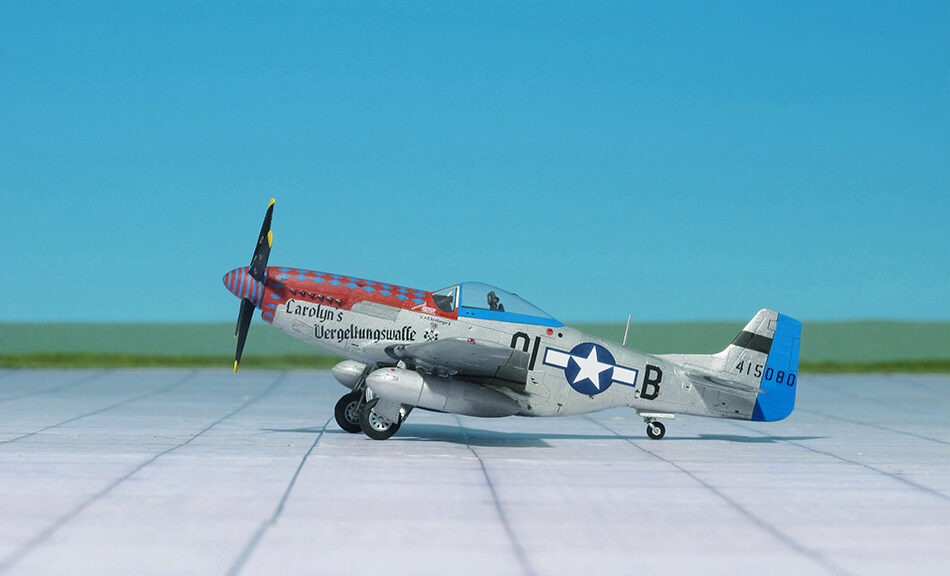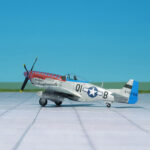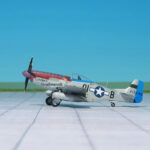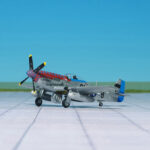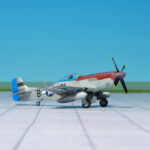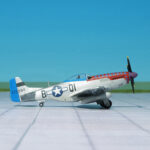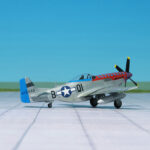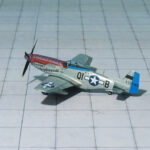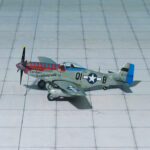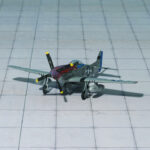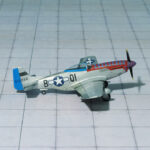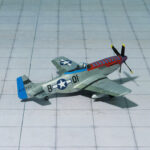TYPE: Long-range fighter and fighter-bomber
ACCOMMODATION: Pilot only
POWER PLANT: One Packard (Rolls Royce) V-1650-7 Merlin liquid-cooled engine, rated at 1,720 hp at WEP (War Emergency Power)
PERFORMANCE: 440 mph
COMMENT: The North American Aviation P-51 Mustang was an American long-range, single-seat fighter and fighter-bomber used during World War II and the Korean War, among other conflicts. The Mustang was designed in 1940 by a team of North American Aviation (NAA) in response to a requirement of the British Purchasing Commission. The commission approached NAA to build Curtiss P-40 fighters under license for the Royal Air Force (RAF). Rather than build an old design from another company, NAA proposed the design and production of a more modern fighter. The prototype NA-73X airframe was completed on 9 September 1940, 102 days after contract signing, achieving its first flight on 26 October.
With the limitations for fighter duties due to the Allison engine, nevertheless the P-51 Mustang had good ground attack potential and its high speed at low altitude made it ideal for tactical reconnaissance. To enhance altitude capabilities, a mockup was devised in England to use the Rolls-Royce Merlin engine in the P-51 airframe. One concept was to locate the new engine behind the cockpit, but this idea was rejected and the Merlin was mounted in the conventional position in the nose. Four airframes were adapted in England to take the Merlin engine. These four planes known as Mustang Xs had deep intakes below the engine for carburetor air. The results of the British tests were passed on to North American.
In the meantime, North American had undertaken a similar conversion project and was building two Packard Merlin-powered P-51 Mustangs. The level airspeed increased by 51 mph, to 441 mph. The airframes were strengthened to accommodate the extra power, the ventral radiator was deepened and the carburetor intake was moved from above the nose to below, to accommodate the Merlin updraft induction system. Even before the Army’s Merlin powered Mustangs had flown, the US Army ordered 2,200 of the more powerful fighters. For a short time, this model was designated XP-78, then redesignated as XP-51B.
25 P-51Bs and 275 P-51Cs were given the British designation Mustang III. The California Mustangs were known as the P-51B-NA and the Dallas, Texas facility produced the P-51C-NT. The Merlin powered P-5lB and its Dallas-built twin, the P-51C, began operations in December 1943.
A further improvement to the Mustang was introduced when a graceful teardrop canopy was installed to eliminate the dangerous blind area created by the faired cockpit. This canopy was already appearing on the British Hawker Typhoon.
This new variant of the Mustang was designated P-51D. 280 P-51Ds were given the RAF designation Mustang IV. The P-51D became the version produced in the greatest quantities with 7,954 being completed.
The P-51D model carried six .50 caliber machine guns with a total of 1,880 rounds instead of the four guns mounted in the P-51Bs. Other refinements, such as moving the wing forward slightly and provisions for rocket launchers were included. The first P-51Ds types were delivered without dorsal fins, but this feature was added to compensate for keel-loss when the bubble canopy was adopted.
The P-51D with the dorsal fin represented the most typical Mustang configuration. The wingspan was 37 feet with an area of 233 square feet and was 32 feet 3 inches long. Height was 13 feet 8 inches. The Packard-built Merlin V-1650-7 was capable of delivering 1,695 hp which provided a speed of 437 mph at 25,000 feet. Weights were 7,125 lbs. empty and 10,100 lbs. normal gross, but an additional 2,000 lbs. could be carried. Internal fuel capacity was 105 gallons, giving a range of 950 miles at 362 mph speed at 25,000 feet and up to 1,650 miles with external tanks.
The aircraft shown here belonged to the 361st FS, 356th FG, 8th AF, stationed in 1945 at , England (Ref.: The Aviation Online Museum).
